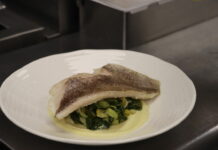 At Tortilleria Sinaloa on Eastern Avenue, men in thick wool shirts buttoned over hooded sweatshirts eat posole. They lift spoons to mouths to taste the pork-enriched broth. They add spoonfuls of chopped white onion and pinches of cilantro, and lift again, this time chewing steadily on the nuggets of hominy that have opened and bloomed like popcorn in the soup. Never mind that it’s morning and that each opening of the door brings a slice of frigid winter air. Never mind that the metallic squeal and grinding of the tortilla machine makes conversation all but impossible. The posole, its steam warming their faces more than the weak sunshine coming through the plate glass storefront, is their focus.
At Tortilleria Sinaloa on Eastern Avenue, men in thick wool shirts buttoned over hooded sweatshirts eat posole. They lift spoons to mouths to taste the pork-enriched broth. They add spoonfuls of chopped white onion and pinches of cilantro, and lift again, this time chewing steadily on the nuggets of hominy that have opened and bloomed like popcorn in the soup. Never mind that it’s morning and that each opening of the door brings a slice of frigid winter air. Never mind that the metallic squeal and grinding of the tortilla machine makes conversation all but impossible. The posole, its steam warming their faces more than the weak sunshine coming through the plate glass storefront, is their focus.
It is my focus, too. This morning, Isabella Leon, a four-year employee of the tortilleria owned by Melissa and Robert Willingham, is going to show me how to make the spicy soup.
My curiosity about posole springs from a curiosity about hominy. Lately I’ve been seeing hominy as a recipe ingredient in contemporary food magazines, like the Chili with Guajillo and Ancho Chiles and Hominy featured in a recent Food and Wine. But like many of my generation, hominy is an enigma. I know it’s a corn product and a staple in some Southern kitchens. I have a vague memory of seeing cans in someone’s pantry. To be frank, I’d been turned off by descriptions of it as congealed (who wouldn’t?) until I first ate hominy in posole, a dish that has grown in popularity in Baltimore thanks to the Mexican cooks who serve it in the Latin American restaurants that populate Fells Point.
A little research reveals that hominy is no newcomer to the city. Philip Stieff’s compilation “Eat, Drink, and Be Merry in Maryland” features a recipe for “Hominy Chafing Dish,” a rich dish of hominy baked with butter and cream. More recently, recipes for hominy muffins and hominy with sausage and pan gravy are included in John Shields’ “The Chesapeake Bay Cookbook.” And, as I learn, it wasn’t that long ago that East Baltimore boasted one of the region’s best known hominy producers, Mrs. Manning’s Hominy.
A conversation with Mrs. Manning’s grandson, Parkville resident Chris Manning, kick-starts my hominy education. He explains that hominy is the dried cracked kernels of white corn that have been steamed to both plump the kernels and allow the hull to be peeled away (a similar product, whole kernel hominy, depends on lye for peeling the hull). “To make it from scratch yourself, it takes a long time,” says Manning. “It’s very tedious.” In that sense, he muses, his grandmother’s canned hominy was “one of the first fast [prepared] foods.”
Margaret Manning, a German emigrant, began selling her homemade hominy, along with other products like sauerkraut, door to door in 1904. By 1917, her hominy was so popular that the family began mass producing it under the name “Mrs. Manning’s Hominy” from a packing house at 803 S. Clinton St. Chris Manning even remembers hearing a live local radio ad during World War II when he was 12 or 13, in which the announcer extolled “the virtues of Mrs. Manning’s Hominy”… saying “Don’t forget to look for Mrs. Manning on the can.” He pauses adding, “That’s what’s known as a blooper.”
During the Depression, Baltimoreans turned to hominy as an inexpensive, filling side dish, says Chris Manning, who still eats hominy the way he ate it growing up at that time. “I put it in a pot,” he explains. “Heat it up. I add a little milk and a pat of butter and maybe a little bit of pepper. You don’t need to add salt. When you heat it, it uncongeals.” Manning says the hominy is especially good with sausage or pork chops, particularly if you replace the butter with a little pork fat from the skillet.
According to Manning, the Mannings’ cannery was the last remaining canning factory in Baltimore City until the business was sold in 1995 to Lake Packing Co. Inc. in Lottsburg, Va., who retained the name but moved the operation. Even the can’s packaging is the same as it was—a clean white label with “Manning’s” in red capital letters above a blue bowl of the fluffy white hominy and “ALL NATURAL HOMINY” in yellow on a navy band below. The only change may be the addition of “Maiz Pozolero” on the label, a nod to a new wave of immigrants seeking out hominy for posole.
At Tortilleria Sinaloa, however, Isabella Leon uses dried hominy rather than canned in the posole, explaining that the dried hominy has more flavor. She begins by boiling the dried hominy in water until the kernels are soft. Every so often she reaches in with a spoon, pulls out some hominy and prods and scrapes the hull with a French manicured fingernail to see if the hull is loose. When it’s ready, she rinses the hominy, and puts it back in the pot to boil for another half-hour with a large, peeled onion and a small handful of garlic cloves.
“Everyone in Mexico eats posole,” says Isabella, while she defrosts the pink and white pork ribs and split pig’s feet that will go into the stew. In Mexican homes, it’s made for birthdays, Christmas or whenever a family gets together. The tortilleria makes posole several times a week, although at busy times it can be made twice a day. All of the women at the shop take turns making the soup, and while they might vary their recipe at home, making a green posole using green peppers and tomatillos or creating their stock with chicken, here at the tortilleria, Isabella explains, the posole is pork-based and red.
To make the “red,” Isabella and I pull the stems off of dried shiny red guajillo peppers that have been soaking in water, and push them into a blender with an onion, garlic and water. Once the mixture is blended into a tomato colored cocktail, Isabella strains it into a bowl where, separated from its skins and seeds, the mixture loses its redness and becomes a bright luminous orange. It looks dangerous and spicy, but it smells (and tastes) fresh, like the juicy ripeness of a raw red bell pepper.
Once the pork has cooked in the hominy broth for about 30 minutes, Isabella ladles several spoonfuls of the guajillo mixture into the soup, adds some salt and it is done. She dips me a small bowl and I inhale the soup’s multi-layered scent before bringing a spoon to my mouth where I taste pork fat, sweet pepper and the chewy nuttiness of the hominy. It is incredibly humble and incredibly good.
I ask Isabella how she learned to make posole, but she simply shrugs and smiles. “Everyone knows how to make it. It just takes a long time,” she says, gesturing to another pot of hominy bubbling on the stove.
Hominy, Oysters and Sausage Dinner
Pork Posole




